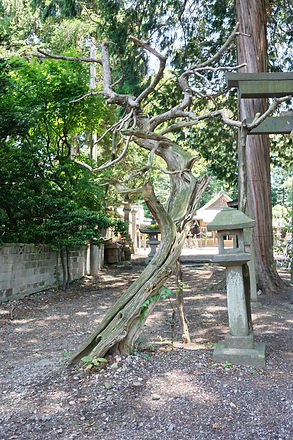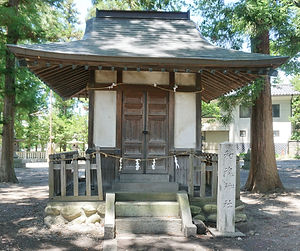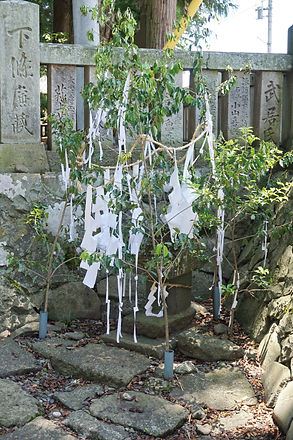普通の外にいくつかの著名な品質を持っている、と畏敬の念を起こさせるあるいかなるビーイングは、カミと呼ばれています。
Nearest station
Midoriko
JR ChūōLine
長野県塩尻市塩尻町6
Nagano-ken, Shiojiri-shi, Shiojiri-machi 6
阿禮神社
Arei Jinja
Home page: none
July 26, 2018
History
The Engi Shiki has a listing for an Arei Jinja (阿礼神社) in Shinano Province, Chikuma-gun and it is thought that this may be the current Arei Jinja. When it was founded is unclear but the shrine legend links it to Susano-o, saying that after slaying the Yamata Orochi in the upper reaches of the Hikawa river in Izumo he materialized at Arahikoyama (荒彦山) in the upper reaches of the Shiokawa river in Shinano Province and destroyed another demon. It is probable that Arahikoyama is the mountain now called Iodo-san(五百渡山). This meritorious feat is said to be the origins of the shrine. In 807, during the Daidō Period, Sakanoue Tamuramaro is said to have relocated the shrine to where the rear shrine is now located, a place then known as Myōjintaira (明神平). In September 851, Year 1 of the Ninju Period, the shrine's credibility was greatly enhanced when the then gūji was able to enlist divine help in stopping an epidemic which had broken out. The following year another shrine was built in front of the
Enshrined Kami:
Main
From Merged Shrines
Ōnamuchi-kami 大己貴神
Hondawake-no-mikoto 誉田別命
In-ground Shrines:
Wakon Jinja 和魂神社
Arei Tenjin 阿禮天神
Annual Festival: 2nd Sunday of July


rear shrine and Ōnamuchi-kami and Hondawake-no-mikoto were jointly enshrined therein. In 1191 Shiojiri was split into two administrative units, West and East. In the former, Suwa Myōjin was the tutelary deity, while in the Eastern part a Hachiman-Gū was built on the land now occupied by Arai Jinja. Minamoto Yoshinaka is also said to have visited the shrine while raising troops in the area.
Description
About 1.7km from Midoriko Station. The main hall is said to have been rebuilt in 1743 and is quite interesting. For most visitors, however, the shrine's most appealing aspect is surely the pair of large koma-inu in front of the hall. These were erected in 1940 to celebrate the 2600th anniversary of the accession of the first emperor, Jimmu, in 660 BC. The stonemason was Akabane Yōjin (赤羽要人) but I have been unable to find out anything about him. That said, his work speaks for itself.
(Click on images to expand them)


























